ACATS移管の際に必要となる口座番号の見つけ方
お客様のACAT、またはATON移管リクエストを正確に手続きするために、ブローカーはリクエストに記載される口座番号の確認を行います。口座番号が無効な場合、リクエストは却下されます。IBKRでは、お客様が口座番号を確認するにあたって、証券口座のステートメントをご確認いただくようお勧めしております。下記は、一般的な証券会社のステートメントのサンプルより、必要情報がどこに記載されているかの例となります。
Charles Schwab - Broker #0164。 口座番号は通常、すべて数字の8桁になります。
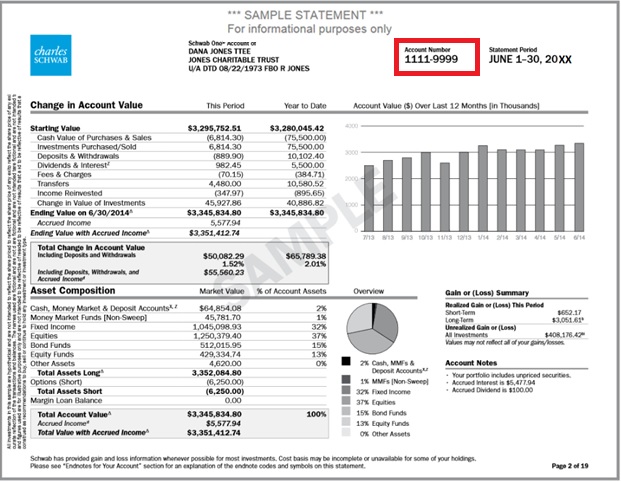
Fidelity Investments - National Financial Services経由での送金/移管。Broker #0226。 口座番号は通常9桁になり、はじめの3桁は英数字、下6桁は数字になります。
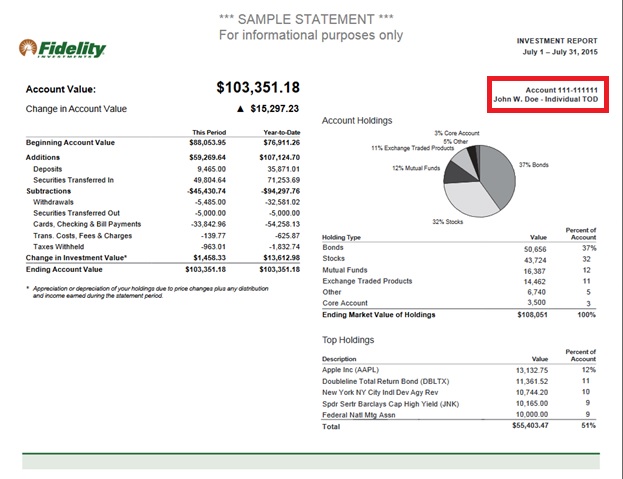
Merrill Edge - Broker #0671。 口座番号は通常8桁になり、アルファベットと数字の組み合わせになります。
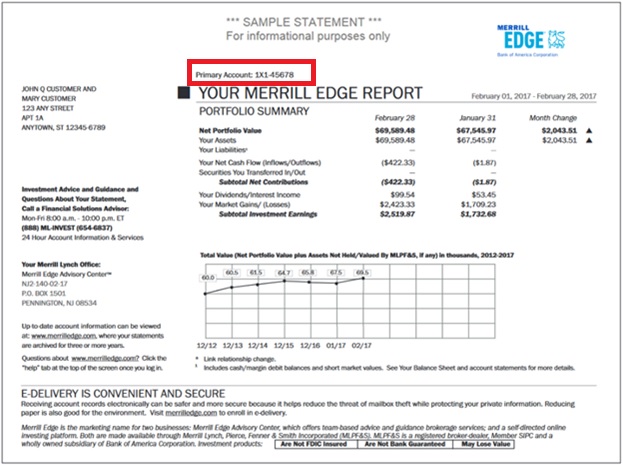
TD Ameritrade - Broker #0188。口座番号は通常、すべて数字の9桁になります。
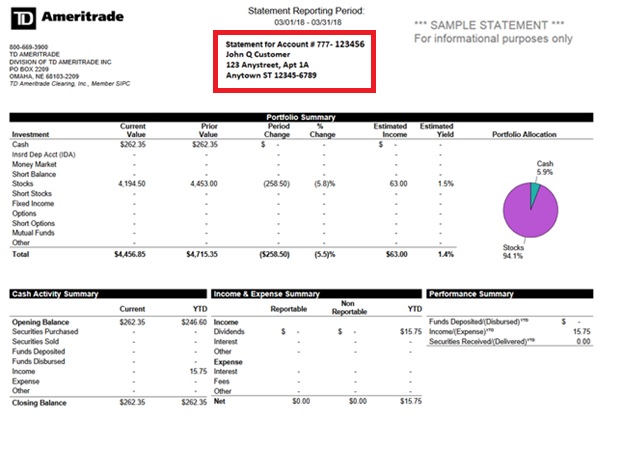
Vanguard- Broker #0062。口座番号は通常、すべて数字の8桁になります。
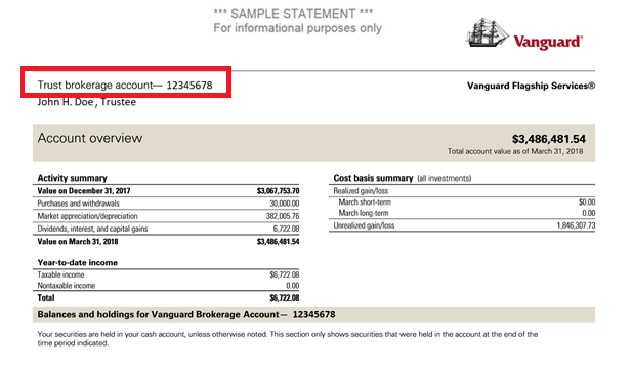
注意事項: こちらの記事には、証券会社のステートメントのサンプル画像が含まれていますが、これは例示を目的としたものであり、各証券会社の所有物であるロゴが含まれている可能性があります。
米国超小型株にかかる規制
イントロダクション
未登録の有価証券の販売に関する規制を遵守し、公開されていない株式の取引に伴う手作業を最小限にとどめるため、IBKRでは米国の超小型株に一定の制限を設けています。下記はこれら規制のリスト、およびこれに関連してよくあるご質問をまとめたものになります。
超小型株にかかる規制
- IBKRでは、資格対象となるお客様からの超小型株の移管のみを受付けており、以下の条件を達成している口座が対象となります: (1) 株式(移管前または後を問わず)を500万ドル以上保有する口座、または運用資産総額が2,000万ドル以上のファイナンシャルアドバイザーのクライアント、 かつ (2) 米国超小型株の占める割合が保有資産の半分以下であること。
- IBKRでは、対象となるお客様が株式を公開市場で購入したこと、またはSECに登録したことを確認できる場合に限り、米国超小型株のブロックの移管を受付けております1。
- IBKRでは、OTCがCaveat Emptor、またはGrey Marketとしてデザインした米国超小型株の移管、またはオープン注文を、いかなるお客様からも受け付けることができません1。該当する株式をポジションに既にお持ちのお客様は、ポジションの決済は可能です。
- IBKRでは、弊社で建てたショートポジションをカバーするための米国超小型株の移管を受付けておりません。
- 約定のみのお客様(IBKRで約定し、他社で決済される場合)は、IBKR口座において米国超小型株のお取引はできません。(米国登録のブローカーのお客様は例外となることがあります)
超小型株に関してよくあるご質問
米国超小型株とは何ですか?
「超小型株」とみなされるのは (1) 店頭取引される株式、または (2) NasdaqやNYSE Americanに上場されている株式のうち、時価総額が5000万ドルから3億ドルの間で、5ドル以下で取引されているものを指します。この方針において超小型株とは、時価総額が5000万ドル以下の米国の公開企業の株式で、ナノキャップ株とも呼ばれ、一般的に超小型株に関連する市場で取引されるものを含みます。
短期的な株価の変動によって再分類が繰り返される事態を避けるため、米国超小型株に分類された銘柄は、30日連続で時価総額と株価の両方が、それぞれ3億ドルと5ドルを超えるまで、現在の分類が継続されます。
超小型株は低価格のものが多いため、一般的にペニーストックと呼ばれています。IBKRでは、低価格で取引されている銘柄で最近に時価総額が大きくなったものなど、例外を設けることがあります。また、IBKRでは非米国企業のADRは超小型株とはみなしません。
超小型株はどこで取引されますか?
超小型株は通常、証券取引所ではなく、店頭市場で取引されます。OTC Bulletin Board(OTCBB)やOTC Markets Group(OTCQX、OTCQB & Pinkなど)が経営する市場などのOTCシステムにおいて、マーケットメーカーによって電子的にクオートされることがよくあります。また、Caveat Emptor、Other OTCやGrey Marketと呼ばれる、上場していない銘柄もこのカテゴリーに含まれます。
また、米国の規制当局はNasdaqまたはNYSE Americanに上場している銘柄のうち、取引価格が$5以下で、時価総額が3億ドル以下のものも超小型株とみなします。
資格対象となるクライアントから移管されてくるポジションの一つ以上が超小型株の場合にはどうなりますか?
IBKRが超小型株のブロックを含む移管を受けた場合、資格対象となるクライアントが、株式が公開市場で購入されたか(他ブローカー経由で公開市場での購入)、 S-1またはこれと同様の登録書によってSECに登録されたことを証明する適切な書類を提出しない限り、IBKRは移管に含まれる超小型株ポジションの売却を制限する権利を有します。
対象となるお客様は、株式が公開市場で購入されたことの証明として、これを反映した、信頼できるブローカーからの証券取引明細書、またはトレード・コンファメーションをご提出ください。対象となるお客様は、株式が登録されたSECファイル番号(および株式が登録書に記載されているものであることを必要な書類)のご提供によって、株式の登録を証明することができます。
注意事項: 規制対象となる株式を他社へ移管することは、すべてのお客様に可能になっています。
IBKRではプライム口座に規制を設けていますか?
アクティビティにプライムサービスが含まれるお客様は、IBKRが執行ブローカーから受け入れることに同意した取引のみに対し、資格対象となるものとみなされます。プライム口座は、IBKRで超小型株を売却することができますが、これらの株式には、IBKRが上記の手続きに基づいて株式の再売却が可能であることを確認するまで、規制が適用されます。
公開市場で購入した株式の規制を解除するには、株式が公開市場で購入されたことが記載される公式な口座明細書か、この内容のレターを執行した株式会社に会社のレターヘッド付きの紙に署名を入れて発行してもらって下さい。レターか明細書には以下の情報が含まれている必要があります。また、株式が募集によって取得された場合には、レターや明細書には、関連する登録届出書の文書やリンクを含めて、株式がその一部であることを明確にする必要があります。
証券会社からのレターに含まれるべき内容:
1) IBKR口座の番号
2) IBKR口座の名義
3) 取引日
4) 決済日
5) シンボル
6) サイド
7) 価格
8) 数量
9) 執行時間
10) 取引所
11) 署名が入っていること
12) 会社の公式レターヘッドを使用すること
サマリー: ロングポジションの規制がなくなった場合には、ロングの売り取引が受付可能になります。ショートの売り取引も受付可能になります。買いのロング取引は受付可能ですが、規制の解除に十分な情報をコンプライアンスが確認できるまで、ポジションには規制がかかったままとなります。買いのカバー取引および日中の往復取引はできません。
購入した株式が、Grey MarketやCaveat Emptorに再分類された場合にはどうなりますか?
IBKR口座で購入した株式が、後日、Caveat Emptor、またはGrey Market株式に分類された場合、ポジションの維持、決済、移管は可能ですが、増やすことはできません。
超小型株が口座で取引できなくなるにはどういった理由がありますか?
超小型株の取引に規制が設けられるにあたっては、2つの基本的な理由があります:
- 発行体との提携の可能性: 米国証券取引委員会(「SEC」)ルール144では、発行体の関連会社による株式(超小型株を含む)の取引に一定の規制が設けられています。ルール144(「ルール144境界値」)の取引量の境界値に近い超小型株の取引活動や保有が見られた場合、IBKRではコンプライアンスによる審査が完了するまで、超小型株の取引に規制を設けることができます。
- 超小型株の移管: IBKR口座に最近、超小型株を移管された場合には、コンプライアンスによる審査が完了するまで、この有価証券の取引に規制がかかることがあります。
上記の理由のいずれかに該当する場合には有価証券の取引に規制が設けられ、アカウント・マネジメント経由でお客様にメッセージが送信されます。通知には規制の理由および解除にあたってお客様に必要となる手順が記載されます。
なぜ私が超小型株発行体と関連性があるものとみなされる可能性があるのでしょうか?
「関連会社」とは、発行体をコントロールする関係にある執行役員、取締役、大株主などの人物を指します。
ルール144は、超小型株を含める有価証券すべてに適用されます。しかしながら、超小型株の取引に関連するリスクが高まっているため、お客様の超小型株の取引および/または保有がルール144の境界値に近い場合、IBKRでは超小型株の取引に規制を設けます。 この規制は、お客様の潜在的な関連性に関するコンプライアンス調査が行われるまで有効となります。
潜在的な関連性確認の審査を受けるにあたり、なぜ2週間ごとに新しく審査を頼まなければいけないのでしょうか?
お客様の関連性ステータスは、IBKRが上記の潜在的関連性の審査を完了した直後に変更される可能性があります。このためIBKRでは、お客様の取引活動や超小型株の保有量がルール144の境界値に近い場合、2週間ごとに潜在的関連性の確認を行うことが適切であると考えております。
IBKRが米国超小型株として指定している株式のリストはどこから確認できますか?
IBKRで米国超小型株と指定している株式のリストは: www.ibkr.com/download/us_microcaps.csvよりご確認いただけます。
リストは毎日更新されます。
超小型株の詳細はどこから入手できますか?
関連するリスクを含める超小型株の詳細は、SECのウェブサイトをご参照ください: https://www.sec.gov/reportspubs/investor-publications/investorpubsmicrocapstockhtm.html
-----------------------------------------------------------
1これには様々な方法による移管(ACATS,、DWAC、FOPなど)、カナダで上場される銘柄の米国での等価物への「サウスバウンド」移管による変換、既存のショートポジションをカバーするための移管、IBプライムのお客様が他ブローカーで約定しIBKRでクリアリングするものなどが含まれます。
Locating your account number for ACATS transfers
In order for your ACAT or ATON transfer to be completed successfully, your broker must validate the account number provided on the request. If the account number is invalid, your broker will reject the request. IBKR recommends that clients review a copy of their brokerage statement to confirm their account number and has provided statement samples below from some of the more common brokers highlighting where this information can be found.
Charles Schwab - Broker #0164. Account Number convention is 8 characters, all numeric.

Fidelity Investments - Delivers through National Financial Services, Broker #0226. Account Number convention is 9 characters, first 3 alpha-numeric and last 6 numeric.

Merrill Edge - Broker #0671. Account Number convention is 8 characters, combination of alpha and numeric.

TD Ameritrade - Broker #0188. Account Number convention is 9 characters, all numeric.

Vanguard- Broker #0062. Account Number convention is 8 characters, all numeric.

Note: This article contains images of sample broker statements which are for illustrative purposes only and which may contain logos that remain the property of each of those brokers.
U.S. Microcap Stock Restrictions
Introduction
To comply with regulations regarding the sale of unregistered securities and to minimize the manual processing associated with trading shares that are not publicly quoted, IBKR imposes certain restrictions on U.S. Microcap Stocks. A list of those restrictions, along with other FAQs relating to this topic are provided below.
Microcap Restrictions
- IBKR will only accept transfers of blocks of U.S. Microcap stocks from Eligible Clients. Eligible Clients include accounts that: (1) maintain equity (pre or post-transfer) of at least $5 million or, clients of financial advisors with aggregate assets under management of at least $20 million; and (2) have less than half of their equity in U.S. Microcap Stocks.
- IBKR will only accept transfers1 of blocks of U.S. Microcap Stocks where the Eligible Client can confirm the shares were purchased on the open market or registered with the SEC;
- IBKR will not accept transfers1 of or opening orders for U.S. Microcap Stocks designated by OTC as Caveat Emptor or Grey Market from any client. Clients with existing positions in these stocks may close the positions;
- IBKR will not accept transfers of U.S. Microcap Stocks to cover a short position established at IBKR;
- Execution-only clients (i.e., execute trades through IBKR, but clear those trades elsewhere) may not trade U.S. Microcap Stocks within their IBKR account. (IBKR may make exceptions for U.S.-registered brokers);
Microcap FAQs
What is a U.S. Microcap Stock?
The term “Microcap Stock” refers to shares (1) traded over the counter or (2) that are listed on Nasdaq and NYSE American that have a market capitalization of between $50 million to $300 million and are trading at or below $5. For purposes of this policy, the term Microcap Stock will include the shares of U.S. public companies which have a market capitalization at or below $50 million, which are sometimes referred to as nanocap stocks or trade on a market generally associated with Microcap Stocks.
To avoid situations where minor, short-term fluctuations in a stock price cause repeated reclassification, any stock classified as U.S. Microcap will remain in that classification until both its market capitalization and share price exceed $300 million and $5, respectively, for a 30 consecutive calendar day period.
As Microcap Stocks are often low-priced, they are commonly referred to as penny stocks. IBKR may make exceptions, including for stocks traded at low prices that recently had a greater market cap. In addition, IBKR will not consider ADRs on non-US companies to be Micro-Cap stocks.
Where do Microcap Stocks trade?
Microcap Stocks typically trade in the OTC market, rather than on a national securities exchange. They are often electronically quoted by market makers on OTC systems such as the OTC Bulletin Board (OTCBB) and the markets administered by the OTC Markets Group (e.g., OTCQX, OTCQB & Pink). Also included in this category are stocks which may not be publicly quoted and which are designated as Caveat Emptor, Other OTC or Grey Market.
In addition, U.S. regulators also consider stocks listed on Nasdaq or NYSE American trading at or below $5 with a market capitalization at or less than $300 million to be Microcap Stocks.
What happens if IBKR receives a transfer from an Eligible Client where one or more of the positions transferred is a Microcap Stock?
If IBKR receives a transfer containing a block of a Microcap stock, IBKR reserves the right to restrict the sale of any Microcap position(s) included in the transfer unless the Eligible Client provides appropriate documentation establishing that the shares were either purchased on the open market (i.e., on a public exchange through another broker) or were registered with the SEC pursuant to an S-1 or similar registration statement.
Eligible Clients can prove that shares were purchased on the open market by providing a brokerage statement or trade confirm from a reputable broker reflecting the purchase of the shares on a public exchange. Eligible Clients can establish that the shares are registered by providing the SEC (Edgar system) File number under which their shares were registered by the company (and any documents necessary to confirm the shares are the ones listed in the registration statement).
NOTE: All customers are free to transfer out any shares we have restricted at any time.
What restrictions will IBKR apply to Prime accounts?
Clients whose activities include Prime services are considered Eligible Clients solely for the purposes of those trades which IBKR has agreed to accept from its executing brokers. However, while Prime accounts may clear U.S. Microcap Stocks at IBKR, those shares will be restricted until such time IBKR confirms that the shares are eligible for re-sale under the procedures discussed above.
To remove the restriction for shares purchased on the open market, please have the executing broker provide a signed letter on company letterhead or an official Account Statement stating that the shares were purchased in the open market. The letter or statement must also include the below required criteria. Alternatively, if the shares were acquired through an offering the letter or statement must provide documents or links to the relevant registration statement and state that the shares were part of it.
Required Broker Letter Criteria:
1) IBKR Account Number
2) IBKR Account Title
3) Trade Date
4) Settlement Date
5) Symbol
6) Side
7) Price
8) Quantity
9) Time of Execution
10) Exchange
11) Must be signed
12) Must be on Firm's official letterhead
To summarize: Sell Long trades will be accepted if the long position is no longer restricted. Sell Short trades will be accepted. Buy Long trades will be accepted and the position will be restricted until Compliance is provided with sufficient information to remove the restriction. Buy Cover trades and intraday round trip trades will not be accepted.
What happens if a stock you purchase gets reclassified as Grey Market or Caveat Emptor?
If you purchase a stock in your IBKR account that at a later date becomes classified as a Caveat Emptor or Grey Market stock, you will be allowed to maintain, close or transfer the position but will not be able to increase your position.
What are some of the reasons why Microcap Stock trading may be restricted in my account?
There are two primary reasons why you might be restricted from trading in a Microcap Stock:
- Potential Affiliation to Issuer: U.S. Securities and Exchange Commission (“SEC”) Rule 144 places certain limitations on trading of stocks (including Microcap Stocks) by an “affiliate” of the issuer. If IBKR observes trading activity or holdings in a Microcap Stock that are close to the trading volume thresholds under Rule 144 (“Rule 144 Thresholds”), IBKR may restrict the customer from trading the Microcap Stock until a compliance review is completed.
- Transfer of Microcap Stock: If the customer has recently transferred a Microcap Stock into their IBKR account, IBKR may restrict the customer from trading in that security until a compliance review is completed.
If one of the above reasons apply, trading will be restricted in the security and a notification will be sent to the customer’s message center in Account Management. This notification will describe the reason for the restriction and the steps the customer must take before IBKR will consider lifting the restriction.
Why does IBKR consider me to be a potential affiliate of a Microcap Stock issuer?
An “affiliate” is a person, such as an executive officer, a director or large shareholder, in a relationship of control with the issuer.
Rule 144 applies to all securities, including Microcap Stocks. However, given the heightened risks associated with trading Microcap Stocks, if a customer’s trading and/or holdings in a Microcap Stock are close to the Rule 144 Thresholds, IBKR will restrict the customer’s trading in the Microcap Stock. This restriction will remain in effect pending a compliance review into the customer’s potential affiliate status.
For the Potential Affiliate review, why do I need to ask for a new review every two weeks?
A customer’s affiliate status may change soon after IBKR completes the above-referenced Potential Affiliate review. As such, IBKR believes it is appropriate to refresh a Potential Affiliate review every two weeks if a customer’s trading activity and/or holdings in the Microcap Stock remain close to the Rule 144 Thresholds.
Where can I find a list of stocks that IBKR has designated as U.S. Microcaps?
A list of stocks designated as U.S. Microcaps by IBKR is available via the following link: www.ibkr.com/download/us_microcaps.csv
Note that this list is updated daily.
Where can I find additional information on Microcap Stocks?
Additional information on Microcap Stocks, including risks associated with such stocks may be found on the SEC website: https://www.sec.gov/reportspubs/investor-publications/investorpubsmicrocapstockhtm.html
-----------------------------------------------------------
1This includes transfers by any method (e.g., ACATS, DWAC, FOP), conversion of Canadian listings to their U.S. equivalent via “Southbound” transfer, transfers to cover existing short positions, IB Prime customers executing with other brokers and clearing to IBKR, etc.
ACATS Transfer Guide (US brokerage account transfers)
ACATS Transfer Guide
Introduction
Understanding the basic facts about transferring accounts between US brokerage firms can be help to avoid delays. Through this article and other Knowledge Database resources, Interactive Brokers seeks to assist with your incoming and outgoing ACATS requests.
US brokerage firms utilize a standardized system to transfer customer accounts from one firm to another. Known as the Automated Customer Account Transfer Service or ACATS, the process allows assets to move seamlessly between brokerage firms in a unified time frame. ACATS transfers are facilitated by a third party, the National Securities Clearing Corporation (NSCC), to assist participating members with timely asset transfers.
ACATS Transfer Benefits
The majority of assets may be transferred between US brokerage firms and some banks through ACATS. This standardized system includes stocks, US corporate bonds, listed options, unit investment trusts, mutual funds, and cash. Information on assets eligible for transfer is provided at "Assets Eligible..." Though impacted by multiple factors and time constraints, the accepted or rejected transfers finalize within 10 business days in most cases.
Navigating The Process
4 simple steps of the ACATS process will help you understand the flow and minimize delays. Familiarizing yourself with the transfer process helps to ensure a successful transition.
1. Incoming or Outgoing
Incoming ACATS Transfers
The financial institution that is receiving your assets and account transfer is known as the "receiving firm." Investors always work with and through the "receiving firm" to move full or partial account assets into a new broker.
Contact the "receiving firm" (Interactive Brokers) to review the firm's trading policies and requirements. You should verify that your assets are eligible for trading at the "receiving firm" before initiating the transfer request. Not all ACATS transferable assets are acceptable for trading at every brokerage firm.
Outgoing ACATS Transfers
All outgoing ACATS transfers, full or partial, must be approved by the "delivering firm." Investors, however, should work with and through the "receiving firm" in order to begin the the transfer process or to status the progress of the request.
2. Initiating Your Transfer
Investors must always begin the ACATS transfer with the "receiving firm." An ACATS transfer form or Transfer Initiation Form (TIF) must be submitted. The "receiving firm" takes your reqeust and communicates with the "delivering firm" via ACATS. The process begins with this request for transfer of the account.
For your Interactive Brokers Account, the transfer is usually submitted online. Video instruction on submitting the transfer is provided at "How to deposit funds via a full ACATS/ATON Transfer." or through Step-by-step instructions.
Note: Outgoing account transfers from your IB account should be directed to the other broker. Your request will be submitted to IB from the other broker through the ACATS electronically.
3. What to Expect
Your Account
Brokers ensure the safety and security of transfer requests by only authorizing requests between open accounts that meet the following criteria:
- Same Account Title
- Same Tax ID Number
- Same Account Type
Transfer Approval
Ultimately responsible for validating the transfer, the "delivering firm" may accept information from the "receiving firm" correcting data originally entered. Approved or validated requests result in the delivery of positions to the "receiving firm" for their acceptance. Assets may not be accepted by the "receiving firm" for the following:
- Non-marginable or Margin (credit) violation
- Not Tradable
- DTC Chill
Note: The most common reasons for ACATS rejections are outlined by clicking here.
Processing Time-frame
The processing time for each transfer request is fixed. In general, approved transfers complete within 4 to 8 business days. Almost all transfers complete within 10 business days. Each firm is required to perform certain steps at specific intervals in the process. Feel free to review the Full ACATS transfer process flow.
Fees
While Interactive Brokers does not charge a fee to transfer your account via ACATS, some brokers do apply a fee for full and partial transfers. Prior to initiating your transfer, you should contact the "delivering firm" to verify any charge.
4. Who To Contact For Help
Interactive Brokers Customer Service stands poised to assist with your incoming ACATS transfer reqeust. Click here for Customer Service contact resources.
Note: Outgoing or ACATS transfers sending accounts to another broker should be directed to the "receiving firm." Their Account Transfer Group will work with Interactive Brokers directly to complete your outgoing request.
Free of Payment (FOP) Transfers
Free of Payment (FOP) is term used by IB to refer to a process of transferring long US securities between IB and another financial institution (e.g. bank, broker or transfer agent) through the Depository Trust Company (DTC).
The FOP transfer method is often used when:
1. The delivering form is not a DTC ACAT (Automated Customer Account Transfer) Participant.
2. The customer would like to expedite the delivery of their securities. The processing time frame for securities transferred via FOP may, in certain instances, be less than that associated with an ACATS transfer.
The following steps are to be followed in order to create a FOP notice:
1. Log into Account Management.
2. Select Funding or Funds Management and then Position Transfers.
3. From the drop-down list, select the Transfer Method: Free of Payment.
4. Select the applicable transaction Type: Deposit or Withdraw.
5. In the case of a FOP Withdrawal, the steps are as follows:
- Select the Destination to whom the securities are being transferred.
- Enter your account number of the Third Party Broker Acount Information.
- Specify the security (Stock, Warrants or US Bonds).
- Enter the Symbol, Shares and the Exchange (optional) and click Add.
- Provide your electronic signature authorizing the transfer request and clicking on the Continue button.
- Verify your identity by entering your password and clicking on the Confirm Request button;
- If your account is enrolled in the Secure Transaction Program (STP), the processing of your request will take place once you enter your confirmation code and click on the Confirm Request button. If not STP enrolled, your request will be subject to security verification, requiring that you contact our Customer Service Center to validate your identity and request.
6. In the case of a FOP Deposit, the steps are as follows:
- Select the Source to whom the securities are being transferred.
- Enter your account number of the Third Party Broker Acount Information.
- Specify the security (Stocks, Warrants or US Bonds).
- Enter the Symbol, Shares and the Exchange (optional) and click Add.
- Provide your electronic signature authorizing the transfer request and clicking on the Continue button.
- A printable version of the FOP request is made available should your transferring firm require an authorization form.
7. Transfer requests are typically completed within five business days.
IMPORTANT NOTE:
While IB does not assess a fee to process FOP transfers, other firms may and we therefore recommend that you confirm with the contra-firm their policies in this regard prior to submitting a request. In the event a contra-firm does charge a fee to IB, the fee will be passed to the IB account holder.
Assets eligible to be transferred through ACATS
Instruments handled by the ACATS system include the following asset classes: equities, options, corporate bonds, municipal bonds, mutual funds and cash. It should be noted; however, that ACATS eligibility does not guarantee that any given security will transfer as each receiving broker maintains its own requirements as to which asset classes as well as securities within a particular asset class it will accept.
Account holders are encouraged to use the Contract Search link on IB’s homepage to assess transfer eligibility prior to initiating a full account transfer request. In the case of mutual funds, please click here for a list of fund families and funds offered by IB.
How do I transfer my US securities positions from my current broker to IB?
Broker to broker transfers for US securities are conducted via a process known as the Automated Customer Account Transfer Service or ACATS. This process generally takes between 4 to 8 business days to complete in order to accommodate the verification of the transferring account and positions. The request is always initiated via the receiving broker (IB in this case) and can be prompted by following the steps below.
1. Log into Account Management and select the Transfer & Pay and then Transfer Positions menu options.
2. From the Transaction Type drop-down list select 'Inbound Position'
3. From the Method drop-down list select 'ACATS'.
4. Enter the sending Broker Information in the fields provided, and click CONTINUE
5. In the Transaction Information section, indicate whether or not you wish to transfer all assets and select Yes to the authorization option.
a. Note that a "transfer all assets" election does not require that you specify any assets as an attempt will be made to transfer your account in its entirety. Account holders should note, however, that certain positions may not be on the list of securities eligible to trade at IB and others, while transferable, may be subject to a house margin requirement higher than that of the delivering broker. In the event IB receives an asset list from the delivering broker which includes ineligible positions or the aggregate of the positions transferred are such that a margin deficit would exist were the transfer to occur, IB will attempt to contact you to remedy the situation within the allocated time frame after which an automatic reject of the full transfer would take effect. Account holders may wish to minimize potential delays or problems associated with a ‘Full’ transfer request by verifying security eligibility and margin requirements via the Contract Search link located at the upper right hand corner of the IB homepage prior to initiating the transfer.
b. If you elect to not "transfer all assets", the system will require that you specify the positions you wish to transfer. Click Add Asset to add the positions you wish to transfer. Fill out the Asset Search and Transaction Information sections and click Continue.
6. On the page that appears, type your signature in the Signature field, and then click CONTINUE.
Click BACK to modify the transfer request.
Please note that brokers generally freeze the account during the transfer period to ensure an accurate snapshot of assets to transfer and may restrict the transfer of option positions during the week prior to expiration. You may wish to check with the delivering broker to verify their policy in this regard. In addition, please note if your IB account is currently maintaining positions on margin, any cash withdrawals or adverse market moves could increase the likelihood that your account falls out of margin compliance during the transfer period which may delay or prevent completion of the transfer.
IMPORTANT NOTICE
Applicants may meet the initial account funding requirement through the transfer of securities positions and/or cash via the ACATS system.
